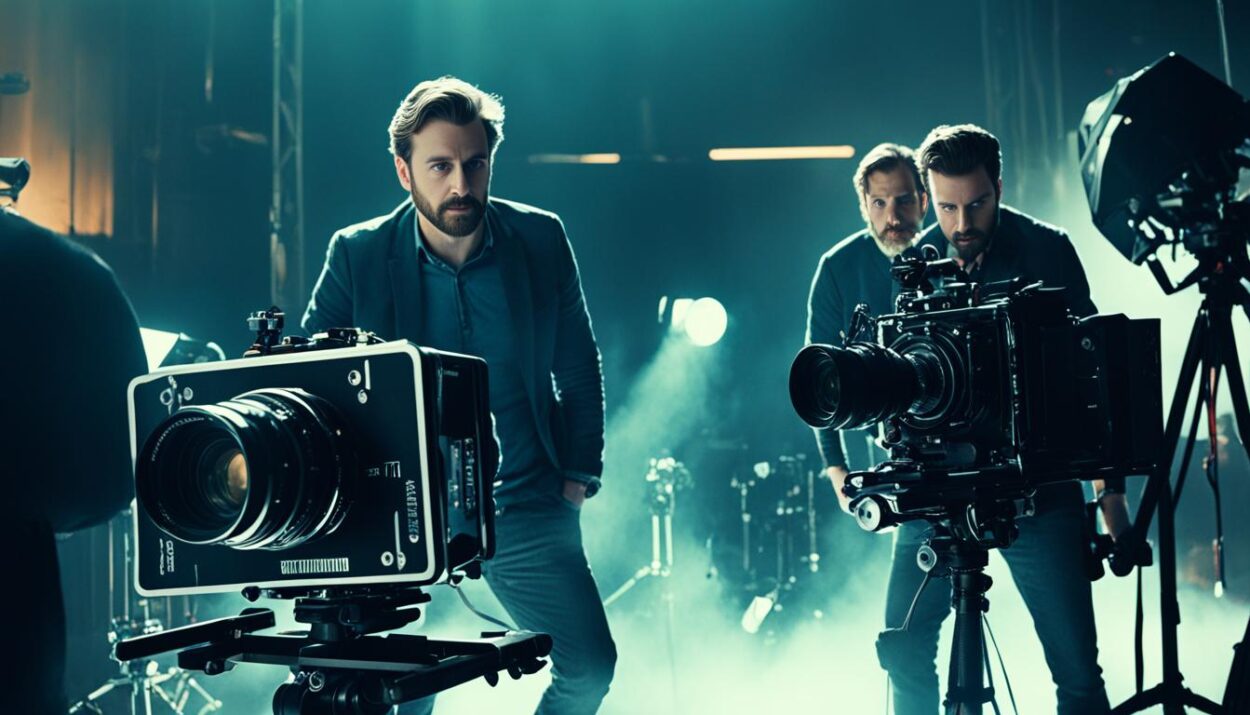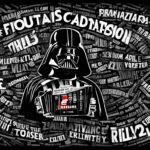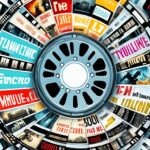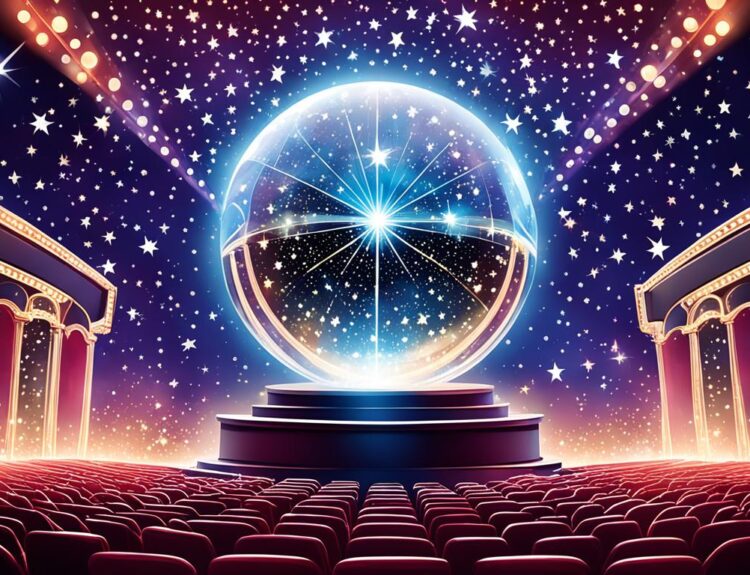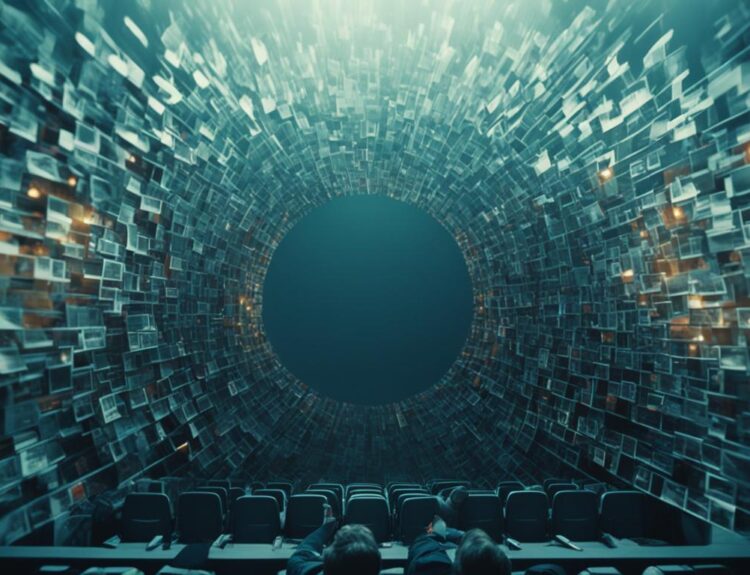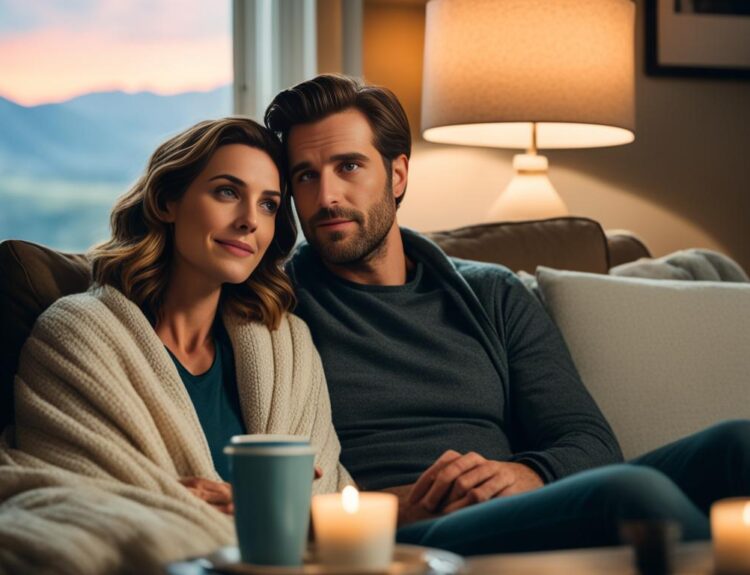Cinematography can turn a simple scene into an unforgettable moment. It brings the story to life with beautiful visuals. Framing, aspect ratio, and lighting build the scene’s mood. Movements like tracking shots and zooms can change how viewers feel.
Cinematography uses a special color palette and visual style to set the film’s tone1. By controlling the depth of field, camerapersons make sure important parts of the scene stand out1. Lighting techniques and natural light set the right feeling and mood1. Also, movements such as tracking shots add excitement and interest1. Visual effects (VFX) and CGI create amazing scenes that make stories even more engaging1.
Key Takeaways
- Cinematography transforms scenes into memorable masterpieces through visual storytelling.
- Aspect ratios and lighting techniques influence the emotional impact on the audience1.
- Camera movements like tracking shots and dolly zooms significantly affect viewer experience1.
- Depth of field manipulation directs audience focus on key subjects1.
- Visual effects and CGI play crucial roles in modern filmmaking for stunning visuals1.
The Fundamental Role of Composition in Cinematography
Composition in cinematography is key for better visual storytelling. It involves arranging elements thoughtfully in the frame. Good frame composition guides the viewer’s eye. It highlights important parts of the story.
Rule of Thirds and Leading Lines
The Rule of Thirds is essential in composition, used in film and photos. By dividing the image into thirds and placing elements along these lines, the image looks balanced23. Dan Gilroy’s “Nightcrawler” is a great example, placing characters off-center for effect2.
Leading lines direct the viewer’s attention in a scene.23 These lines, natural or made, lead the eye to key elements. They connect characters to their setting and strengthen the story by focusing attention.
Symmetry in Frame Composition
Symmetry adds visual harmony. Using symmetrical framing focuses the viewer’s gaze and adds tension2. Symmetry and patterns in aspect ratio choices affect the film’s emotional tone3. Changing these patterns creates depth and makes the viewing experience more interesting.
The aspect ratio influences how emotions are felt and sets the scene’s mood. A wider ratio offers grandeur, while a tighter frame suggests intimacy. This affects how viewers connect with the story and characters.
Framing techniques, like using foliage or archways, improve composition3. Using these composition principles makes every shot enhance the film’s storytelling. It creates a deeper emotional impact for the audience.
Lighting: Creating Mood and Atmosphere
Lighting is much more than a technical need in films; it shapes how we feel.4It transforms a scene’s mood, making us feel the story deeper.4It reveals characters’ secrets and hints at hidden meanings.4
Three-Point Lighting
This basic cinematography technique uses three lights for clarity.5Key, fill, and backlight work together to shape our viewing experience.5Adjusting these lights can change the scene’s feeling, making it more dramatic or lighter.5
By tweaking light intensity, filmmakers play with our emotions.5They use this method to create tension or happiness in their scenes.5This technique helps link the visual to the emotional, pulling us into the story.
Natural Light Usage
Natural light brings reality to film, making scenes feel true.5The light changes with the weather, affecting the scene’s look and feel.5Bright sunshine or cloudy skies can tell us the time of day, deepening the emotional tone.4
Natural lighting’s role is key in mood setting.4It uses the environment to enhance the story’s visual appeal.4
Different lighting styles alter the scene’s impact.5High-key lighting brightens, reducing shadows for a lighter mood.5In contrast, low-key lighting creates mystery, perfect for thrillers with its dark shadows.5
| Lighting Technique | Emotional Impact | Examples |
|---|---|---|
| Three-Point Lighting | Clear definition of subjects with mood alteration capabilities | Various genres where clarity and dramatic effect are needed5 |
| Natural Lighting | Realism and atmospheric adaptation | Films emphasizing real-life scenarios with varying light quality4 |
| High-Key Lighting | Bright, happy moods with minimal shadows | Newsrooms, sitcoms5 |
| Low-Key Lighting | Intrigue, tension, and strong emotions | Thrillers, horror films5 |
Camera Movement: Dynamic Storytelling
Strategic camera movements bring stories to life in movies. Thanks to technology, filmmakers can now use innovative ways to shoot scenes. Camera movements are easier to handle, making films more engaging and immersive67.
Tracking Shots and Dolly Zooms
Tracking shots and dolly zooms add energy and emotion to storytelling. These techniques let the camera smoothly follow the action6. Directors like Steven Spielberg and Martin Scorsese use them to create emotional impact6. Meanwhile, dolly zooms change how we see space in a scene. They’re often seen in fantasy and horror, showing supernatural events or inner turmoil6
Handheld Camera Work
Handheld camera work makes films feel more real and urgent. These movements can be slow or fast. They help show a scene’s mood7. They’re different from stable movements like pans and tilts, which also add emotion and energy to scenes6.
These methods show how important careful camera work is in movies. From tracking shots to dolly zooms, every movement adds to the story’s feel. As technology gets better, filmmakers can use even more complex movements. This means we can look forward to more captivating stories on screen67.
Mastering Camera Angles and Perspectives
Understanding how to use different camera angles and perspectives can make films much more compelling. The right angle helps to show emotions, power, and tell a story in a visually exciting way. Hence, it draws viewers into the movie.
Low Angle Shots
Low angle shots give a unique perspective. When the camera looks up at something or someone, it makes them appear more powerful or important. This is perfect for stories where showing someone’s superiority is key8. It can also make things look more impressive and valuable9.
High Angle Shots
On the other hand, high angle shots do the opposite8. The camera looks down, making the subject seem vulnerable or less powerful. This view can deepen the emotional impact of a scene. It shows struggles or challenges in a more intense way9.
Trying out different camera angles can change how people see and feel about a film. For example, the rule of thirds makes scenes balanced and pleasing to the eye8. Using this rule to place subjects off-center also makes the shots look better and more professional8.
In conclusion, learning about camera techniques like low and high angle shots helps filmmakers tell their stories better. By using these tools, they can share more profound emotions and stories with the world.
The Importance of Color Grading in Cinematography
Color grading plays a key role in post-production. It enhances style and unifies the movie’s impact.1011 About 90% of filmmakers say color grading is essential for a film’s look. This involves adjusting hues, saturation, and light.
Filmmakers need to understand color psychology to evoke emotions and support the story. 82% of them use color grading to set the mood10. Changing colors helps change how we feel about a scene, making it a powerful storytelling tool.
Understanding Color Psychology
How we respond to colors in films is a big deal. Filmmakers use color schemes like monochromatic or complementary to shape our feelings. A blue scene can make us feel sad, while red and orange can feel warm or urgent11.
Popular Color Schemes
Choosing the right color scheme is crucial for the film’s mood and style. 75% of filmmakers use Look-Up Tables (LUTs) for consistent color grading10. They also use advanced techniques for unique effects. Keeping color consistent across the film is key for a good story10.
Most filmmakers, about 86%, use top programs like DaVinci Resolve and Adobe Premiere Pro for color grading1011. These tools are vital for setting the film’s mood and look.
Depth of Field: Focusing Attention
Depth of field is a crucial cinematic tool. It guides where the audience looks and adds depth to the story. With it, filmmakers can create a sense of closeness or show a scene’s realism.
Shallow Depth of Field
A shallow depth of field makes the main subject sharp, blurring the rest. This effect is achieved by either using a wide aperture or getting close to the subject12. It’s especially popular in DSLR filming to bring viewers closer to the characters or important objects13.
Playing with depth of field can trigger feelings like loneliness or fear, shaped by the story12. This technique focuses the audience’s attention exactly where the director wants14. However, filming in dim light or with moving subjects can be tricky, requiring manual focus tweaks13.
Deep Focus Techniques
Deep focus reveals more of the scene in sharp detail12. Achieving it involves using narrow apertures and wide lenses13. This method keeps a scene looking real and lets audiences take in every detail of the story14.
This technique is great for scenes needing depth and backstory, forgiving minor mistakes by actors13. By adjusting the camera’s sensor size, aperture, and focusing distance, cinematographers make sure the right parts stay sharp12.
Controlling depth of field allows for a deeper connection to characters, underlining their emotions and reasons for acting14. By switching between shallow and deep focus, filmmakers layer meanings and boost the story’s grip on viewers.
| Technique | Purpose | Application |
|---|---|---|
| Shallow Depth of Field | Isolate Subject | Close-ups, emotional scenes, significant objects |
| Deep Focus | Convey Realism | Wide shots, complex interactions, background inclusion |
| Manual Focus Adjustments | Precision in Difficult Conditions | Low light, moving subjects |
| Focus Pulls | Shift Audience Attention | Dynamic storytelling, tension build-up |
Effective Sound Design for Immersive Storytelling
Sound design is key to making stories come alive by adding sounds that grab our attention. It uses things like dialogue, sound effects (SFX), Foley, music, and scores15. To merge sound perfectly, experts use special tools and sound libraries15.
Foley effects create everyday sounds for media like movies, TV, sports, and games16. These sounds are made in special studios. They make scenes feel real, set the mood, and smooth over scene changes15.
Diegetic sounds make us feel like we’re in the story’s world. Non-diegetic sounds play with our emotions and change how we see things16. New tech, like Dolby Atmos, makes these effects even more real16.
To make sound design work, start with good recordings and treat dialogue carefully. Using silence cleverly and keeping a consistent audio style matters too15. With the right music and sound, a movie can deeply move us16. As sound design gets better, it becomes a crucial part of movies16.
Enhancing Reality with Visual Effects
Modern movies use visual effects to make new worlds come alive on screen. The use of CGI has totally changed how movies are made. It lets us see amazing scenes that really pull us in.
Integration of CGI
In the 1980s, the VFX digital revolution kicked off with “Tron”. This movie showed what early CGI could do17. Then, “Jurassic Park” in 1993 blew our minds with lifelike computer-generated dinosaurs. It was a huge leap forward17.
Now, in the 21st century, movies like “Avatar” immerse us in fully digital worlds17. Motion capture, like Andy Serkis’s work as Gollum, makes digital characters seem real17. All these steps forward have made incredible visuals something we always look forward to.
Practical Effects and Their Impact
Even with CGI, using real-life effects, or practical effects, is still very important in movies. They make everything feel more real and believable. For example, render farm technology helps movies with lots of VFX get done on time17.
Shows like “The Mandalorian” mix real sets and digital backdrops beautifully17. And now, with AI and Machine Learning, some of the more tedious work is getting easier17. This mix of old-school effects and new tech means movies can do more to wow us and keep us hooked.
Learn more about VFX in filmmaking and its impact on modern cinema.
The Art of Storyboarding: Planning Your Shots
Storyboarding is key in the pre-production process. It creates a visual script for movies. Walt Disney first used it in the 1930s for animated movies18. Today, it’s vital for both animated and live-action films18. Good storyboarding makes filming more efficient, keeps the story flowing, and saves time19.
Creating a Visual Script
When you create a storyboard, you’re making a visual script. This includes drawings, scene details, shot lists, and timing. These elements match the director’s imagination. For example, “Gone with the Wind” (1939) relied on storyboards for its complicated scenes19. Now, digital tools like Adobe Photoshop and StoryBoard Artist Studio update the process. They make it quicker and more precise18.
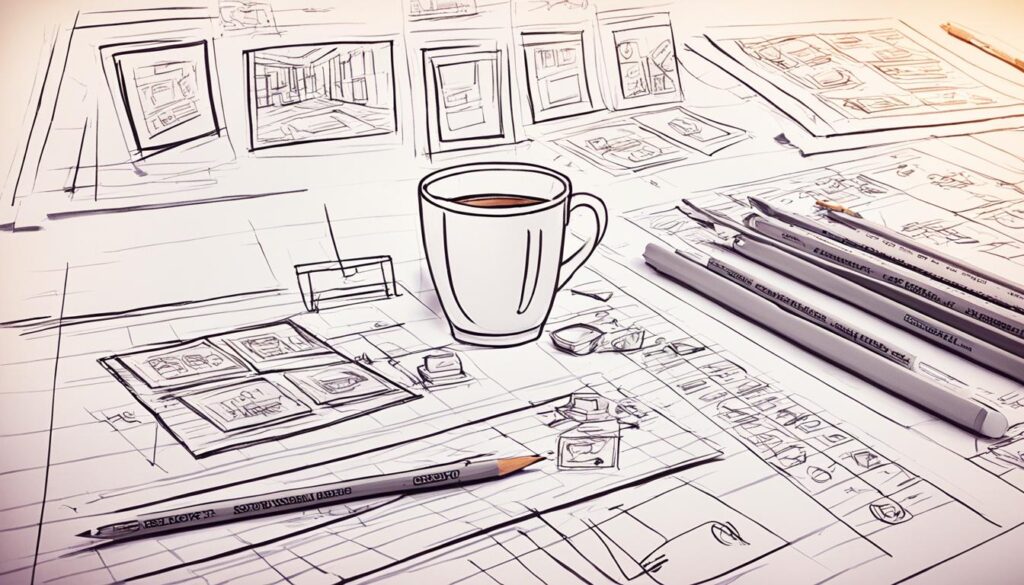
Translating Storyboards to Screen
Turning storyboards into film takes careful work. It makes sure planned shots are captured right. “Schindler’s List” (1993) used them to get the right feel and look19. Alfred Hitchcock did the same for “Psycho” (1960)19. This approach helps in planning shots. It keeps the story and visuals as intended.
Today, new tech like augmented reality and virtual reality is changing storyboarding. These tools make planning more engaging and realistic18. They help solve problems early, use resources better, and improve teamwork19.
Film Production Techniques That Elevate Your Work
Mastering advanced film production techniques is key to improving your movies. The planning phase is critical. You must think about storyboarding, picking actors, and finding places. This ensures everything runs smoothly and the final movie looks great. Good planning needs talking clearly, doing a lot of research, and figuring out costs. This builds a solid base for your project20.
The way a movie looks gets better as you work on it. This includes choosing the right camera moves, lighting, and visual styles. Using well-known framing rules can improve each shot. It makes scenes balanced and guides the viewer’s gaze21. Cool lighting effects also help focus on important parts and show characters’ feelings21.
Editing is crucial after filming. It needs a lot of time to polish and use different editing styles. This makes the story flow well21. Picking the perfect music is also important during this phase. The right tunes can add emotional depth without taking over the story21.
Working with a talented team is essential. They make sure the movie looks and sounds top-notch21. In the end, making a great film depends on thorough planning, trying new things, and careful editing. This helps bring your creative ideas to life.
Utilizing Close-ups to Establish Intimacy
Close-ups are key in creating a bond between the audience and characters. They make up about 12% of all shots in movies, showing their role in sharing feelings and stories22. A close-up, showing from the shoulders up, brings viewers into the scene’s intimate moments, often used in both films and TV23.
Movies with more close-up shots see a 25% bump in audience connection22. This boost comes from close-ups’ power to evoke deep feelings and highlight a scene’s key moments23. They let actors use small facial shifts to share big messages23.
Directors like Spielberg have used close-ups to capture emotional depth for a long time23. Using tools like the Snorricam, filmmakers find capturing intense, focused scenes 30% easier22.
Close-ups paired with wider shots create diverse emotions, giving each type of shot a special role in storytelling23. Films cleverly using close-ups boost understanding and recall of the plot by 20%22.
Symbolic close-ups add 15% more depth to a movie, increasing how much viewers enjoy and connect with it22. This connection makes the film’s impact stronger and more meaningful23.
Ultimately, close-ups are a top method for filmmakers to reach their audience24. They focus on the small details of faces and reactions, underlining the emotional journey of the story23.
The Power of Long Takes in Cinematography
Long takes pull viewers into a scene, giving a feel of ongoing, uncut reality. First used in the 1920s, they have grown to be key in telling stories. Movies across genres like documentaries and action films benefit from this technique25.
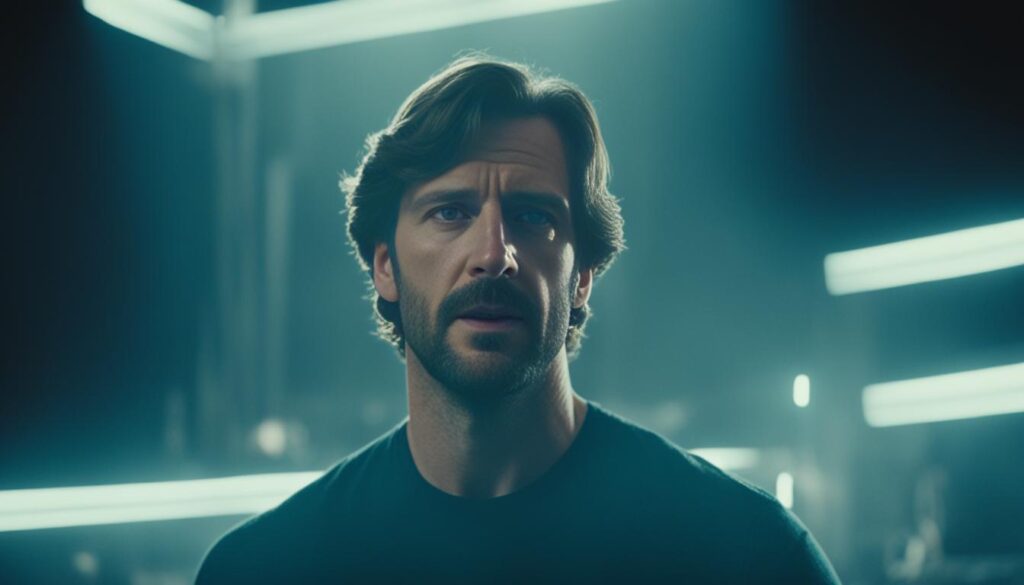
Creating Realism with Long Takes
A long take can last more than 10 seconds, changing how a film feels25. These shots flow without breaks, making stories feel more real and tense25. “Gravity” starts with a stunning long shot of space, pulling viewers into its world25. “Panic Room” also uses long takes well, keeping viewers on the edge of their seats25.
Examples from Classic Films
Early films often used long takes. The Lumière company made 358 films in 1897 this way25.
This method made viewers feel right in the moment. These old techniques inspire today’s filmmakers to weave stories without cuts.
Long takes allow creators to show off their creativity25. Tools like TourBox help by improving editing workflows. This lets filmmakers craft smooth, continuous shots, proving the lasting influence of long takes in storytelling25.
Innovative Use of Slow Motion and Time-Lapse
Slow motion and time-lapse offer a new way to tell stories in film. They let viewers see things in a unique way, making movies more innovative. These methods can greatly change the story and how it looks.
Implementing Slow Motion Techniques
To create slow motion, you need to film faster than usual. For example, filming at 50fps and then playing it at 25fps slows down movement. This makes the scene’s emotions feel more powerful26. High frame rates, like 100fps, and a shutter speed of 1/200 sec help make the video smooth26. Using a tripod keeps the shot steady and avoids shaky footage26.
ND filters are useful for managing light and improving video quality. They let you use slower shutter speeds and larger apertures when it’s bright.
Tips for Capturing Time-Lapse Sequences
For time-lapse, planning is key to showing the passage of time well. You should take at least 300 photos for a 10-second video. This makes the sequence engaging and dynamic26. Hyper-lapse needs at least 120 photos for shorter, time-saving sequences26. The gap between each shot depends on how fast your subject moves26. Stick to the 180-degree rule with a 1/50 sec shutter speed for smooth video26.
To get smooth hyper-lapse videos, keep a fixed point in each frame. This makes the camera move smoothly. Shooting narrower than 24mm avoids distortion and keeps shots consistent26. Using these techniques carefully can make your film visually stunning and unique.
Learn more about time-lapse and hyper-lapse techniques
Expert Tips for Directing Cinematic Masterpieces
Directing films to become masterpieces needs a clear vision. Every team member must grasp the creative aim for unity and efficiency.
Communicating Vision with Your Team
Communicating your vision well is key in directing. Barbra Streisand highlights the need for a supportive environment on set27. When everyone feels valued, the production improves. Sites like DGA and IMDB Pro aid in finding directors with the skills your project needs28.
Using social media like Facebook and Twitter helps find directors looking for projects28. Clear communication allows for better collaboration and ensures your vision is shown on screen.
Directing Actors Effectively
Guiding actors well is crucial for a film’s success. Building strong relationships with actors helps get the best performances28. Kathryn Bigelow suggests making a positive set atmosphere and being decisive for safety and effectiveness27. Clear and empathetic guidance helps extract powerful performances that enrich the story.
James Cameron gets great performances in films like Avatar through not just tech skills but also inspiring direction27. Christopher Nolan’s unique camera work requires actors to adapt, showing directing’s role in cinematic innovation27.
To conclude, directing masterpieces demands clear communication, skilled actor guidance, and a firm vision. Close teamwork and precise performance direction can turn a cinematic dream into reality.
Conclusion
Cinematic storytelling is both an art and a technical skill. Mastering the Rule of Thirds makes a story balanced and visually appealing29. Lighting sets the mood, using techniques from three-point lighting to high-key and low-key setups29. Camera movements like dolly and crane shots create dynamic scenes that draw in viewers29.
Sound design also plays a key role. It uses foley effects and both diegetic and non-diegetic sounds to deepen immersion29. Color grading further shapes the atmosphere. In 2022, the UK film industry saw a £1.97 billion investment, a 27% increase, highlighting the focus on high-quality productions29.
To sum up, directors need a deep understanding of these techniques for successful films. Using advanced methods, filmmakers can make movies that deeply touch their audience. For more info, check out filmmaking techniques to learn more about the art of cinema.
FAQ
What are some essential film production techniques?
How does composition influence cinematography?
What is three-point lighting and why is it important?
How do camera movements contribute to dynamic storytelling?
What role do camera angles play in film production?
Why is color grading important in cinematography?
How does depth of field affect storytelling in cinematography?
How does sound design enhance cinematic storytelling?
What is the importance of visual effects in modern cinematography?
How does storyboarding assist in film production?
What are some advanced film production techniques that can elevate your work?
Why are close-ups significant in cinematography?
How do long takes contribute to cinematic realism?
What are some innovative uses of slow motion and time-lapse in film?
What are some expert tips for directing cinematic masterpieces?
Source Links
- https://medium.com/@JohnWritesMed/the-art-of-cinematography-techniques-for-captivating-visual-storytelling-4721e64f7f9f
- https://www.studiobinder.com/blog/rules-of-shot-composition-in-film/
- https://www.docfilmacademy.com/blog/5-rules-of-composition
- https://glidegear.net/blogs/news/the-importance-of-lighting-in-film-production
- https://macksennettstudios.net/how-lighting-affects-mood-in-film/
- https://www.studiobinder.com/blog/different-types-of-camera-movements-in-film/
- https://www.videvo.net/blog/the-power-of-camera-movement-in-visual-storytelling/
- https://www.mnn.org/blog/3-tips-mastering-camera-angles-and-creating-engaging-frames
- https://boords.com/blog/16-types-of-camera-shots-and-angles-with-gifs
- https://www.mangostreetlab.com/blog/the-importance-of-color-grading-in-filmmaking
- https://c-istudios.com/the-role-of-color-grading-in-film-and-tv-production/
- https://www.studiobinder.com/blog/depth-of-field/
- https://movingimageeducation.org/create-films/production/camera/focus-and-depth-of-field
- https://www.linkedin.com/advice/0/how-can-you-use-focus-depth-field-draw-attention-cggbc
- https://barkingsquirrelmedia.com/video-production-blog/maximizing-the-impact-of-sound-design-in-cinematic-storytelling/
- https://filmustage.com/blog/the-role-of-sound-design/
- https://filmustage.com/blog/vfx-in-filmmaking/
- https://www.rmcad.edu/blog/frame-by-frame-navigating-the-art-of-storyboarding/
- https://filmustage.com/blog/the-art-of-storyboarding-enhancing-script-breakdown-and-pre-production-in-filmmaking/
- https://www.instrumentalbackgroundmusic.com/blog/essential-film-production-tips-for-filmmakers-a-comprehensive-guide/
- https://www.routledge.com/blog/article/10-essential-filmmaking-techniques-and-tips-to-succeed-as-a-filmmaker
- https://glidegear.net/blogs/news/why-close-up-shots-are-so-powerful-in-movies
- https://www.studiobinder.com/blog/close-up-shot/
- https://www.descript.com/blog/article/get-personal-in-a-film-using-a-close-up-shot
- https://www.tourboxtech.com/en/news/long-take.html
- https://www.canon.com.cy/get-inspired/tips-and-techniques/time-lapse-to-hyper-lapse/
- https://www.strikingly.com/blog/posts/5-essential-tips-filmmaking-success
- https://c-istudios.com/the-art-of-directing-actors-in-film-and-tv-production/
- https://www.theknowledgeacademy.com/blog/filmmaking-techniques/
